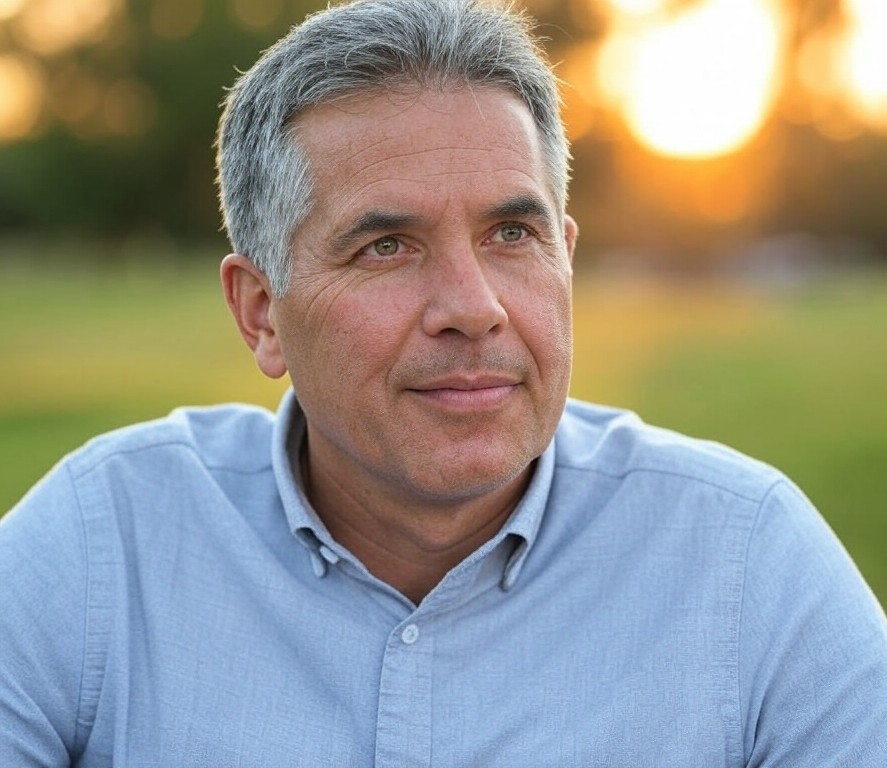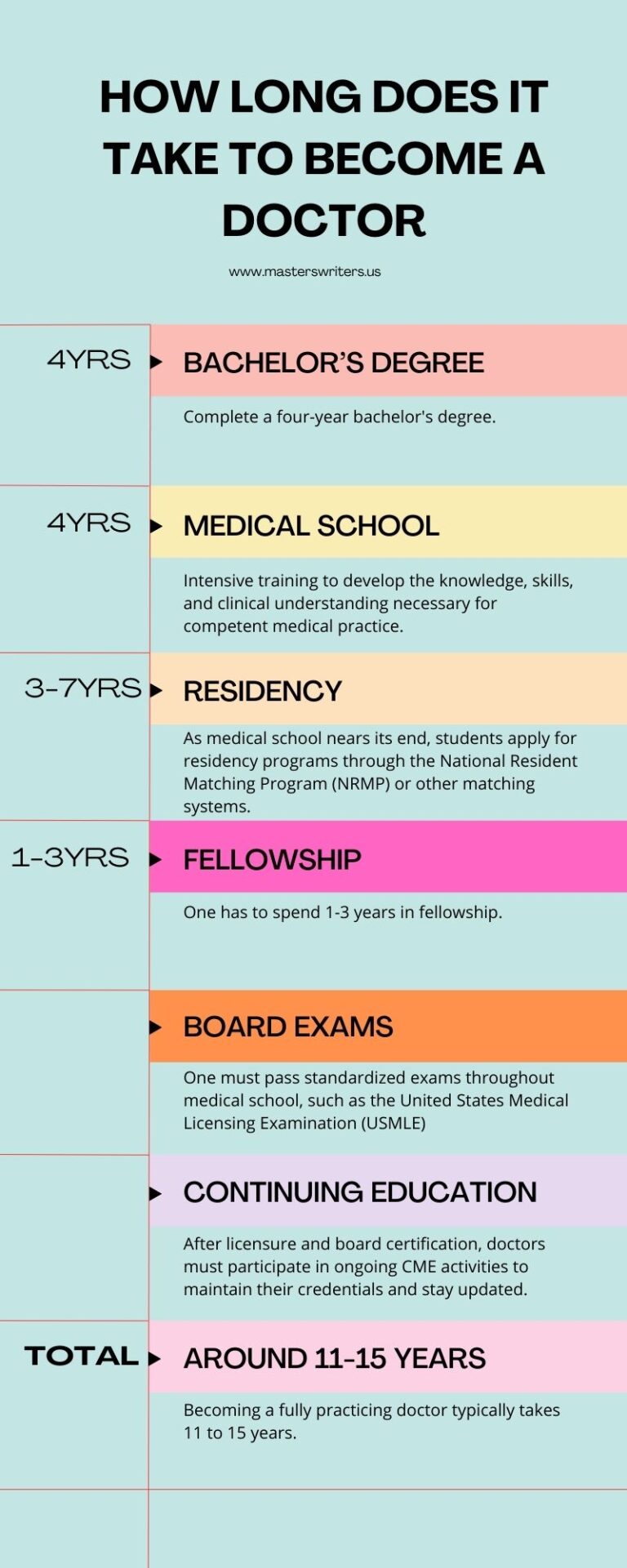Healthcare
How Long Does It Take to Become a Doctor


Becoming a doctor is a significant undertaking, driven by a passion for healing and making a tangible difference in people’s lives. However, it’s not a choice to be made impulsively – it demands unwavering dedication. So, how long does it take to achieve the title of a doctor?
This is a common question for those contemplating a career in medicine. In this article, we’ll break down the path to becoming a doctor, providing clear insights into the time and effort required for this rewarding profession.
Becoming a Doctor: Traditional Way
Pursuing a career as a doctor involves a long and demanding educational journey. This path is fueled by a commitment to healthcare and a desire to impact people’s lives substantially. But how long does it typically take to become a doctor through the traditional route?
The traditional timeline to become a doctor generally spans 11 to 15 years. This journey begins with obtaining a bachelor’s degree, which typically takes around four years, followed by four years in medical school.
Upon graduating from medical school, aspiring doctors enter residency training, which lasts between three and seven years, depending on the chosen specialty. This traditional pathway encompasses a rigorous academic curriculum, extensive clinical rotations, licensing exams, and practical hands-on experience.

Need Help with Medical School Assignments?
Competent writers are online and ready to step in.
The Path to Becoming an MD
Earning a Doctor of Medicine (MD) degree usually takes about eight years after high school. This process involves four years of undergraduate education to obtain a bachelor’s degree and four years in medical school.
Before Medical School
Before entering medical school, students typically complete a four-year bachelor’s degree. This undergraduate education lays the groundwork in sciences and includes prerequisite courses such as biology, chemistry, physics, and mathematics, along with a selection of liberal arts courses.
While no specific major is required for medical school, many students opt for degrees in fields like biology, chemistry, or biochemistry because of their relevance to medical studies.
Many students also engage in extracurricular activities, volunteer work, research, or clinical experiences during their undergraduate years. These activities help strengthen their medical school applications and provide valuable exposure to the healthcare field.
During Medical School
Medical school involves intensive training to develop the knowledge, skills, and clinical understanding necessary for competent medical practice.
How long is medical school? Typically, medical school takes four years, structured as follows:
Preclinical Years: The first two years focus primarily on classroom-based learning. Students cover anatomy, physiology, biochemistry, pharmacology, and pathology. This phase emphasizes understanding the human body’s structure and function and disease mechanisms.
Clinical Rotations: In the third and fourth years, students transition to clinical rotations, working under the supervision of experienced physicians in various medical specialties. These rotations provide hands-on experience in different healthcare settings, including hospitals, clinics, and outpatient facilities.
Core Clerkships: Students rotate through clinical clerkships in internal medicine, surgery, pediatrics, obstetrics and gynecology, psychiatry, and family medicine. They learn to assess patients, develop differential diagnoses, and participate in managing various medical conditions.
Elective Rotations: Besides core clerkships, students may choose elective rotations in specialized areas of medicine that align with their interests and career goals.
Board Examinations: Students must pass standardized exams throughout medical school, such as the United States Medical Licensing Examination (USMLE) or the Comprehensive Osteopathic Medical Licensing Examination (COMLEX).
Residency Preparation: As medical school nears its end, students apply for residency programs through the National Resident Matching Program (NRMP) or other matching systems. They participate in interviews and rank their preferred residency programs to secure a position in their desired specialty.
Here’s a simplified timeline of the traditional path to becoming a doctor:
Stage | Duration |
Bachelor’s Degree | 4 years |
Medical School | 4 years |
Residency Training | 3-7 years |
Total Time | 11-15 years |
This traditional route, while demanding, prepares aspiring doctors with the comprehensive education and clinical experience needed to excel in the medical field.
How Long It Takes to Be a Doctor After Medical School
Completing medical school is a significant milestone, but it’s just the beginning of the final phase of becoming a fully practicing doctor. This next stage is known as residency training, which lasts three to seven years, depending on your chosen specialty.
For those aiming to become even more specialized, additional training through fellowships may be pursued. Fellowships can add up to three more years of training, extending the time it takes to be recognized as an expert in a specific medical field.

Certification and Examinations
Upon completing medical school and residency, aspiring doctors must navigate a series of certification examinations to obtain licensure and board certification in their chosen specialty. These exams can differ based on the country and specialty but typically include the following:
Exam | Description |
USMLE (United States Medical Licensing Examination) | A three-step examination for medical licensure in the United States. Step 1 evaluates basic science knowledge, Step 2 assesses clinical skills and knowledge, and Step 3 tests clinical management abilities. |
COMLEX-USA (Comprehensive Osteopathic Medical Licensing Examination) | A parallel examination series to the USMLE, explicitly designed for United States osteopathic physicians, assesses medical knowledge and clinical skills. |
Board Certification Exams | Specialty-specific exams administered by medical specialty boards to evaluate knowledge, skills, and competency in a particular medical specialty or subspecialty. |
In-Training Examinations | Some specialties require periodic exams to assess residents’ progress and readiness for board certification. |
Continuing Medical Education (CME) | After licensure and board certification, doctors must participate in ongoing CME activities to maintain their credentials, stay updated with medical advancements, and provide high-quality patient care. |
Becoming a Doctor: Alternative Way
The journey to becoming a doctor through alternative pathways can differ considerably from the traditional route. The timeline might be shorter for individuals with prior relevant education and experience, such as nurses, physician assistants, or researchers with advanced degrees.
Accelerated Programs
Accelerated medical programs shorten the combined duration of undergraduate and medical school education, typically reducing it to six to seven years instead of the traditional eight. These programs demand exceptional academic performance and often have stringent eligibility criteria.
Post-Baccalaureate Programs
Post-baccalaureate pre-medical programs offer a viable path for those who need to fulfill prerequisite coursework for medical school. These programs vary in length but generally take one to two years to complete.
In alternative pathways, individuals still attend medical school after completing the necessary coursework and meeting other admission requirements. So, how long does it take to become a doctor through an alternative route? Earning a Doctor of Medicine (MD) or Doctor of Osteopathic Medicine (DO) usually takes four years.
What Is the Shortest Time to Become a Doctor
The shortest path to becoming a doctor typically involves enrolling in an accelerated medical program after high school. These programs, often called “accelerated BS/MD” or “combined BS/MD” programs, streamline the undergraduate and medical school education process.
In these programs, students can start medical school sooner, often after two to three years of undergraduate coursework. Admission to these accelerated programs is highly competitive, requiring candidates to demonstrate outstanding academic achievements, significant extracurricular involvement, and a strong commitment to the medical field.
So, how long does it take to become a doctor through this accelerated route? Generally, it takes approximately six to seven years. This accelerated timeline allows students to embark on their medical careers much sooner than the traditional path. During these years, you may have a task “write my nursing essay,” and our professionals are always ready to give you a hand!
Does It Worth It to Become a Doctor
Deciding if becoming a doctor is worth it is a highly personal decision influenced by numerous factors. For many, the chance to make a significant positive impact on patients’ lives and contribute to the well-being of society is a major motivating factor in pursuing a medical career.
The intellectual challenges, continuous learning opportunities, and the deep sense of fulfillment from helping others can outweigh the sacrifices made during the extensive education and training.
However, the financial burden of medical school debt, the demanding hours, and the emotional toll of patient care are significant considerations. Aspiring doctors must thoughtfully weigh these factors to ensure their career choice aligns with their values, goals, and aspirations.
Additionally, the medical profession offers a wide range of specialization options, research opportunities, and roles in advocacy, enabling doctors to tailor their careers to their interests and strengths.
So, is becoming a doctor worth it? Absolutely! Despite the demanding journey, the potential for personal and professional growth and the opportunity to make a meaningful difference in patients’ lives provide compelling reasons for many to embark on this challenging yet rewarding path.
Final Remarks
Becoming a doctor is a challenging yet incredibly rewarding journey that requires significant time, dedication, and effort. Whether you choose the traditional path, explore alternative routes, or enroll in accelerated programs, the commitment to patient care, continuous learning, and professional growth remains paramount. While the road may be long and demanding, the opportunity to make a meaningful difference in people’s lives and contribute to the advancement of healthcare makes it all worthwhile. Aspiring doctors must carefully consider their motivations, goals, and the realities of the medical profession to determine if this noble career aligns with their vision for the future. Ultimately, the pursuit of becoming a doctor is a testament to one’s passion for healing and dedication to improving the well-being of others.

Medical School Workload Is Getting Tougher?
Opt for academic relief with our professional service.
FAQs
How long does it take to be a doctor?
Becoming a fully practicing doctor typically takes 11 to 15 years. This includes four years of undergraduate education, four years of medical school, and three to seven years of residency training, depending on the specialty.
How many years does it take to be a doctor?
The process to become a doctor generally spans 11 to 15 years. This period includes obtaining a bachelor’s degree (four years), completing medical school (four years), and undergoing residency training (three to seven years).
What is the easiest way to become a doctor?
There is no “easy” way to become a doctor, as all paths require extensive education and training. However, some may consider accelerated medical programs (BS/MD) as a slightly more streamlined option, as they combine undergraduate and medical education into a shorter timeframe, typically around six to seven years.
Which doctor takes the shortest time to become?
The shortest time to become a doctor is typically for those entering primary care fields such as family medicine, internal medicine, or pediatrics. These specialties usually require three years of residency after medical school, which is approximately 11 years.
Sources
BeMo Academic Consulting. How Long Does It Take to Become a Doctor? Shortcuts Included! https://bemoacademicconsulting.com/blog/how-long-does-it-take-to-become-a-doctor
Indeed. How Many Years Does it Take to Become a Doctor? https://www.indeed.com/career-advice/career-development/how-many-years-does-it-take-to-become-a-doctor
The Med Commons. How Long Does it Take To Become a Doctor. https://themedcommons.com/how-long-does-it-take-to-become-a-doctor/

